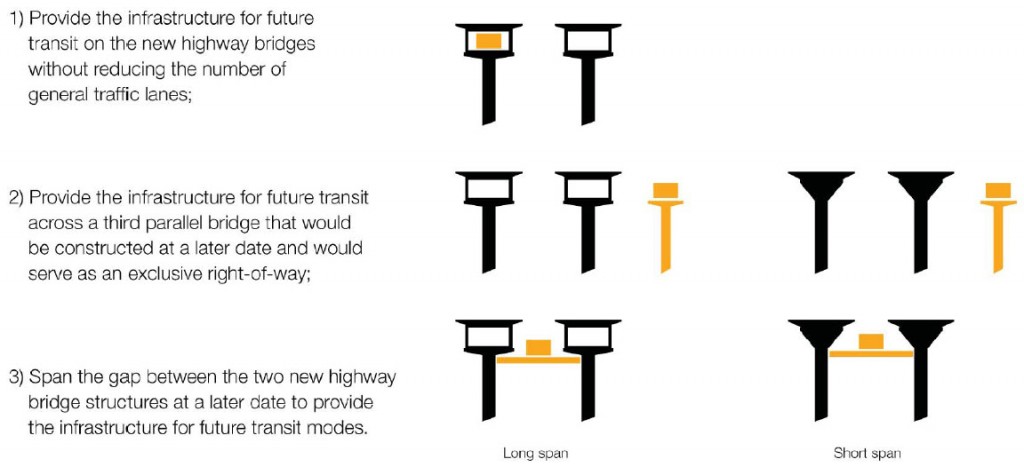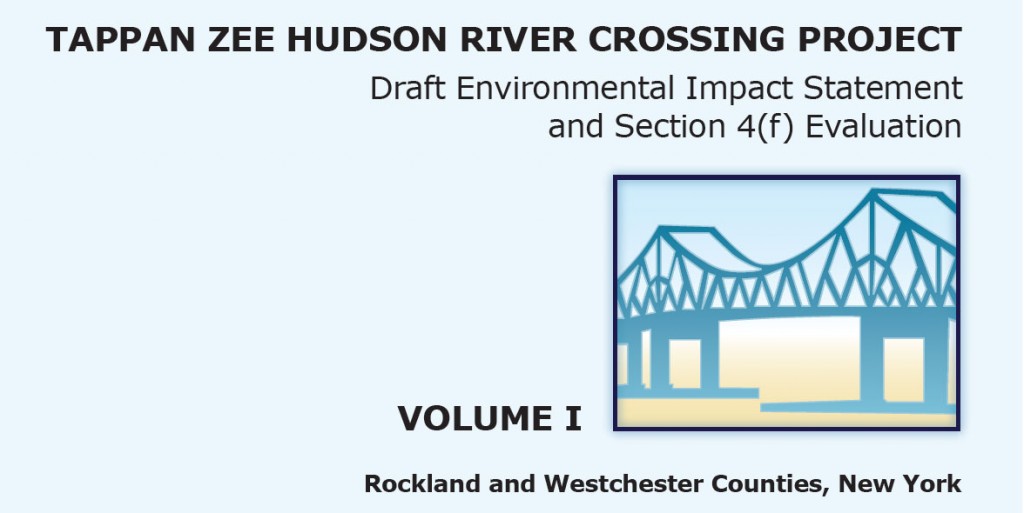The New York State Department of Transportation and New York State Thruway Authority recently released the Draft Environmental Impact Statement (DEIS) for the Tappan Zee Bridge replacement project. Despite popular demand for better public transit in the I-287 corridor, the DEIS makes few provisions for public transportation in the Lower Hudson Valley. Many residents want a bus rapid transit (BRT) system, and Tri-State has set up a website to advocate for BRT’s place in the project.
This is the second installment of a Mobilizing the Region series that explains why the state is wrong to conclude that the Tappan Zee should be built without bus rapid transit (the first installment is available here). Today, we examine whether or not the bridge structure proposed in the DEIS would preclude future transit initiatives. New York State Department of Transportation Commissioner Joan McDonald has said that the new bridge is being built in a way that will allow for public transportation, be it commuter rail or bus rapid transit. However, our analysis shows that the DEIS does not adequately justify this statement. In particular, the landings on either side of the bridge may not be wide enough to accommodate bus rapid transit.
While the state has repeatedly claimed that the Tappan Zee Hudson River Crossing Project “does not preclude future trans-Hudson transit service” in the I-287 corridor, the DEIS suggests that the state has not fully examined how future transit systems would integrate with the proposed two-span bridge design. The document merely includes a diagram and cursory descriptions of possible future transit options.

The diagram and accompanying explanations (DEIS ch. 2, p.6) raise more questions than they answer. Though it is not clear from the illustration, the document text suggests that the left shoulder on each replacement span might be used for exclusive bus lanes in the future. This raises several questions:
- Are there any grading or design features in the current bridge plan that could inhibit or preclude bus rapid transit system operation? For example:
- Are these shoulders – narrowing to 6 feet in one instance near the bridge’s landing – wide enough to accommodate a bus rapid transit system?
- Are these shoulders placed on the bridge in a way that would allow them to seamlessly continue into the corridor as bus rapid transit lanes?
- Bus rapid transit systems typically plan for buses to travel at a certain average speeds. Would the bridge’s grading and design allow buses to travel at such a speed?
The second option proposes the construction of a third, transit-only bridge (see above diagram, number 2). Here are a few potential obstacles to its construction and operation:
- Would a third bridge line up with current and future transportation alignments in the corridor? What type of extra infrastructure, if any, would be needed to allow for transit access and egress?
- What are the environmental ramifications of building a third bridge in the river and how do they impact the feasibility of building one?
- How might the local waterfront communities regard the construction of a third bridge, both now and in the future? How much land acquisition would be necessary?
- Has the state done adequate cost/benefit analysis? Previous studies project that accommodating transit on the dual span bridge today would be less expensive than adding a $2-3 billion third span in the future. Why forego an opportunity to accomplish the same goals for less money?
The last option, which would make space for transit by connecting the proposed Tappan Zee’s twin spans with a third (see above diagram, number 3), is also problematic. More specifically:
- According to the DEIS plan, the gap between the two proposed spans will vary between 0 and 70 feet. Is it feasible to build a third span in a space that varies so dramatically?
- No transit accommodations are planned for the corridor when the two spans are built—will transit access and egress be possible? What type of extra infrastructure would be necessary at the landings in Rockland and Westchester counties? Could money be saved by building transit into the bridge now?


[…] Tri-State: State Docs Don’t Show How “Future Transit” Would Actually Work on the New Tappan Zee […]
The new spans MUST have that lower deck, complete with the railway approaches that would allow the addition of a Cross Westchester Railway for passenger and freight lines.
Think long term!
The problem with the transit proposal that has been proposed in the past is that it focuses on carrying people from Rockland to Manhattan. However, that only represents a tiny portion of the rush hour traffic. Most of the morning commuters are heading to jobs at various office parks along the I 2887 corridor towards Portchester. Existing transit technologies can not serve this market effectively.
However there are several automated rapid transit technologies which are designed to serve a large number of low density destinations. These are lighter weight technologies which could easily be retrofitted onto the new bridge.
I suggest ONLY one highway bridge with the same number of lanes as present plus ONE two track rail bridge connecting in the west with the existing line to Suffern and to a new rail line to at least White Plains with intermediate stops and preferably beyond White Plains to an appropriate station on the New Haven Line. There should be provision for some of the trains to go to Grand Central Terminal. Station platforms east of White Plains could be shorter because only 2 – 4 car trains would be needed. Service should be every 15 minutes Suffern – White Plains and at least every hour, Suffern – Grand Central Terminal. The line should be electrified. It also could be extended northward to Stewart Airport if the Westchester County – Stewart Airport traffic would justify it.
The New York area has some amazing bridges, ones that look great and have fairly high capacity. Good examples, the GW and the VZ. Both are double deckers with lots of lanes. Mind you the ramp systems have issues, but the bridges themselves are impressive and great to look at.
Now we see these horrible plans for a replacement TZ. It’s clearly designed to be as butt ugly as possible, to interfere with views as much as possible, and to be as useless as possible. Build a modern suspension or cable stay bridge with two decks designed to fit in to the beauty of the Hudson River, and at the center of the lower deck have 2 or 4 tracks for transit, and on the top deck have one or two lanes each way for HOV including buses. Build them so they won’t rust away and need constant painting. Hire some designers who actually know what they are doing, and manage this like a real project, not the typical sink hole that all NYS government projects tend to become.
[…] review of the project’s DEIS has revealed questions about how easily the state could add transit to the proposed bridge after its construction. The review also raised serious concerns about the […]
[…] the bridge so as not to actively block transit from being added later — though they’ve refused to verify even this — but there’s a world of difference between that and actually building something that […]
[…] mass transit including bus rapid transit and commuter rail,” but didn’t substantiate this questionable claim. And every indication is that the assertions will not be documented until after the comment […]
ALL THIS TALK OF TRANSIT AND RAIL, ESPECIALLY HEAVY HIGH SPEED TO LONG ISLAND IS DENIED BY THE PRESENT NO FOOTINGS BRIDGE DESIGN. REAL RAIL DEMANDS REAL FOOTINGS TO BED ROCK, WHICH IS 1400 FEET DOWN AT THE WESTERN SHORE. THE PRESENT PLAN MIGHT GO 300 FEET INTO SILT. TUNNELS ON THE OTHER HAND ARE OFTEN DONE IN SILT OR CLAY, AND ARE SEISMIC PROOF–SEE TOKYO BAY OR BART OR THE CHUNNEL. NOW WTH THE NEW TECHNOLOGY OF TBMS THEY ARE ALSO QUICK AND CHEAP– SEE YANGTZE, ELBE,WESTERSHELDE.
[…] sets of comments note that, despite the Cuomo administration’s promises, the DEIS offers no concrete assurance of how the new Tappan Zee design will allow for transit to be built at some point. The coalition […]
[…] sets of comments note that, despite the Cuomo administration’s promises, the DEIS offers no concrete assurance of how the new Tappan Zee design will allow for transit to be built at some point. The coalition […]
[…] sets of comments note that, despite the Cuomo administration’s promises, the DEIS offers no concrete assurance of how the new Tappan Zee design will allow for transit to be built at some point. The coalition […]
[…] (DEIS) (we asked for a variety of documents related to the questionable cost estimates and claims about transit in the DEIS). Yesterday, almost a week after the close of the public comment period, NYSDOT told us […]
[…] Zee Bridge, it isn’t actively blocking the later addition of transit. But there’s little proof that the state’s designs cross even that low bar. For example, buses would theoretically be allowed to run along the new span’s extra-wide […]
[…] the same points Tri-State has been questioning for over a year: claims that the bridge will accommodate future transit and alleviate traffic by reducing crashes (the State still has not addressed these […]
[…] the same points Tri-State has been questioning for over a year: claims that the bridge will accommodate future transit and alleviate traffic by reducing crashes (the State still has not addressed these […]
[…] New York State’s proposed bridge—which lacks the transit component that Lower Hudson Valley residents had previously agreed upon—has attracted concern in New York and across the tri-state region. While the state assures citizens that bus lanes or commuter rail could be added to the bridge later, Tri-State’s analysis has cast this assertion into doubt. […]